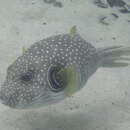Diagnostic Description
provided by Fishbase
This species is characterized by the following: The body is generally greenish-brown in color, the back, sides and caudal fin profusely speckled with white spots, and the belly marked with white bars. A single bent lateral line. Body with small spines except around snout and caudal peduncle. Each nostril with two fleshy solid tentacles. Restricted gill opening.Description: Characterized further by having short and obtuse snout, 2.0-2.3 in head length; bony interorbital width 2.6-3.1 in head length; rounded caudal fin (Ref. 90102).
Diseases and Parasites
provided by Fishbase
Paracardicola Infestation. Parasitic infestations (protozoa, worms, etc.)
Life Cycle
provided by Fishbase
Oviparous (Ref. 205).
Morphology
provided by Fishbase
Dorsal spines (total): 0; Dorsal soft rays (total): 10 - 11; Analspines: 0; Analsoft rays: 10 - 11
Trophic Strategy
provided by Fishbase
Solitary and slow moving. The species occurs in a wide range of habitats from estuaries and inner reef flats and lagoons to a depth of at least 50 m on outer reef slopes. It tends to be more common in sandy to rubble areas than in coral-rich areas. It feeds both during night and day on a wide range of marine organisms, including some algae (Ref. 11889). Omnivore (Ref. 57615).
Biology
provided by Fishbase
Inhabit outer reef slopes to depths of at least 50 m, inner reef flats and lagoons. Juveniles common in weedy areas of estuaries (Ref. 4919). Also found in coastal bays and estuaries, usually near rocky reef or on sand-stretches between reefs with low algae-rubble reef to about 20 meters depth, or in shallow with sparse seagrass growth (Ref. 48637). Benthopelagic (Ref. 58302). Usually solitary and territorial on sandy to rubble areas. Feed on fleshy, calcareous, or coralline algae, detritus, mollusks, tunicates, sponges, corals, zoanthid anemones, crabs, tube worms and echinoderms (Ref. 1602).
Importance
provided by Fishbase
fisheries: minor commercial; aquarium: commercial; price category: very high; price reliability: very questionable: based on ex-vessel price for species in this family
分布
provided by The Fish Database of Taiwan
分布於印度-泛太平洋區,西起紅海、非洲東岸,東至加州、巴拿馬,北至日本南部及夏威夷群島,南至羅得豪島及拉帕群島。台灣各地海域均產。
利用
provided by The Fish Database of Taiwan
肝臟及卵巢具劇毒,不可食用。常被當做觀賞用魚於水族館展示。
描述
provided by The Fish Database of Taiwan
體長橢圓形,體頭部粗圓,尾柄側扁。體側下緣無縱行皮褶。口小,端位;上下頜各有2個喙狀大牙板。吻短,圓鈍。眼中大,側上位。無鼻孔,兩側各具一個叉狀鼻突起。體背腹面,除眼周圍與尾柄後部外,全佈滿小棘。鰓膜黑色。背鰭尖,位於體後部,具軟條10-11;臀鰭與其同形,具軟條10-11;無腹鰭;胸鰭寬短,後緣呈圓弧形;尾鰭寬大,呈圓弧形。背、頭與體側具大小不一的白圓斑,喉部圓斑大,尾柄圓斑小;腹部底具許多平行之深褐色細紋;眼睛與鰓孔周圍有一至三條不明顯之白線;背鰭基與胸鰭基黑色;除胸鰭黃褐色外,各鰭棕色。
棲地
provided by The Fish Database of Taiwan
主要棲息於潟湖和礁區斜坡或水深可達50公尺之礁臺水域,亦有被發現於河口域,通常單獨活動,具領域性。以藻類、碎屑、有孔蟲、多毛類、被囊動物、海綿、苔蘚虫、小型腹足類和魚類等為食
White-spotted puffer
provided by wikipedia EN
The white-spotted puffer fish (Arothron hispidus) is a medium to large-sized puffer fish, it can reach 50 cm length.[3] It is light grey in color, or greyish or yellowish, and clearly covered with more or less regular white points, that become concentric contrasting white and dark grey lines that radiate around the eyes and pectoral fins. The ventral part is white. The "shoulder" (around the pectoral fins) is dark. It also has concentric contrasting white and dark grey lines that radiate around the eyes and pectoral fins. The white spotted puffer fish is poisonous.
Its distribution extends through the Indo-Pacific area, Red Sea included, to the eastern Pacific Ocean.[4] A confirmed record was reported recently from the eastern Mediterranean Sea off Cyprus.[5] It can be found at depths of three to 35 metres. Its habitat types include reefs, lagoons, estuaries, and tidepools. Its diet includes calcareous or coralline algae, molluscs, tunicates, sponges, corals, zoanthids, crabs, polychaetes, starfish, urchins, krill, and silversides.
The adult is nocturnal and solitary. It is territorial, becoming somewhat aggressive.
References
-
^ Hardy, G.; Jing, L.; Leis, J.L.; Liu, M.; Matsuura, K.; Shao, K. (2014). "Arothron hispidus". IUCN Red List of Threatened Species. 2014: e.T193699A2262231. doi:10.2305/IUCN.UK.2014-3.RLTS.T193699A2262231.en. Retrieved 19 November 2021.
-
^ Kottelat, M. (2013). The Fishes of the Inland Waters of Southeast Asia: A Catalogue and Core Bibliography of the Fishes Known to Occur in Freshwaters, Mangroves and Estuaries. The Raffles Bulletin of Zoology, 2013, Supplement No. 27: 1–663.
-
^ "Arothron hispidus, White-spotted puffer : fisheries, aquarium". Fishbase.org. 2012-07-03. Retrieved 2013-09-03.
-
^ "Facts about White-spotted Puffer (Arothron hispidus) - Encyclopedia of Life". Eol.org. Retrieved 2013-09-03.
-
^ Atlas of Exotic Fishes in the Mediterranean Sea (Arothron hispidus). 2nd Edition. 2021. 366p. CIESM Publishers, Paris, Monaco.https://ciesm.org/atlas/fishes_2nd_edition/Arothron_hispidus.pdf

- license
- cc-by-sa-3.0
- copyright
- Wikipedia authors and editors
White-spotted puffer: Brief Summary
provided by wikipedia EN
The white-spotted puffer fish (Arothron hispidus) is a medium to large-sized puffer fish, it can reach 50 cm length. It is light grey in color, or greyish or yellowish, and clearly covered with more or less regular white points, that become concentric contrasting white and dark grey lines that radiate around the eyes and pectoral fins. The ventral part is white. The "shoulder" (around the pectoral fins) is dark. It also has concentric contrasting white and dark grey lines that radiate around the eyes and pectoral fins. The white spotted puffer fish is poisonous.
Its distribution extends through the Indo-Pacific area, Red Sea included, to the eastern Pacific Ocean. A confirmed record was reported recently from the eastern Mediterranean Sea off Cyprus. It can be found at depths of three to 35 metres. Its habitat types include reefs, lagoons, estuaries, and tidepools. Its diet includes calcareous or coralline algae, molluscs, tunicates, sponges, corals, zoanthids, crabs, polychaetes, starfish, urchins, krill, and silversides.
The adult is nocturnal and solitary. It is territorial, becoming somewhat aggressive.
- license
- cc-by-sa-3.0
- copyright
- Wikipedia authors and editors
Description
provided by World Register of Marine Species
Inhabits outer reef slopes to depths of at least 50 m, inner reef flats and lagoons and estuaries. Usually solitary and territorial on sandy to rubbly areas rather than on coral-rich areas. Occurs at 25 °C. Feeds on fleshy, calcareous, or coralline algae, detritus, molluscs, tunicates, sponges, corals, zoanthid anemones, crabs, tube worms and echinoderms.
Froese, R. & D. Pauly (Editors). (2023). FishBase. World Wide Web electronic publication. version (02/2023).
- license
- cc-by-4.0
- copyright
- WoRMS Editorial Board

